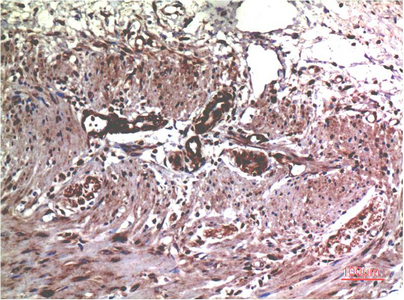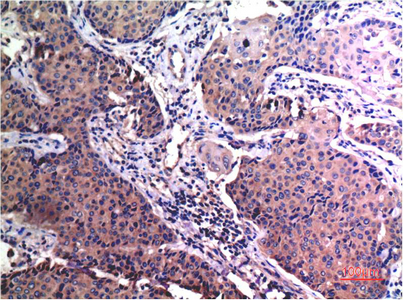MMP2 mouse Monoclonal Antibody(1H1)
- Catalog No.:YM3667
- Applications:WB;IHC;IF
- Reactivity:Human;Rat;Mouse
- Target:
- MMP-2
- Fields:
- >>Endocrine resistance;>>Leukocyte transendothelial migration;>>GnRH signaling pathway;>>Estrogen signaling pathway;>>Relaxin signaling pathway;>>AGE-RAGE signaling pathway in diabetic complications;>>Pathways in cancer;>>Proteoglycans in cancer;>>Bladder cancer;>>Diabetic cardiomyopathy;>>Fluid shear stress and atherosclerosis
- Gene Name:
- MMP2
- Protein Name:
- MMP2
- Human Gene Id:
- 4313
- Human Swiss Prot No:
- P08253
- Mouse Swiss Prot No:
- P33434
- Rat Swiss Prot No:
- P33436
- Immunogen:
- Synthetic Peptide of MMP2 at AA range of INTERNAL
- Specificity:
- MMP2 protein detects endogenous levels of MMP2
- Formulation:
- Liquid in PBS containing 50% glycerol, 0.5% BSA and 0.02% sodium azide.
- Source:
- Monoclonal, Mouse
- Dilution:
- IHC 1:100-200,WB 1:500-2000. IF 1:50-200
- Purification:
- The antibody was affinity-purified from mouse ascites by affinity-chromatography using specific immunogen.
- Concentration:
- 1 mg/ml
- Storage Stability:
- -15°C to -25°C/1 year(Do not lower than -25°C)
- Other Name:
- MMP2
- Observed Band(KD):
- 64,72kD
- Background:
- matrix metallopeptidase 2(MMP2) Homo sapiens This gene is a member of the matrix metalloproteinase (MMP) gene family, that are zinc-dependent enzymes capable of cleaving components of the extracellular matrix and molecules involved in signal transduction. The protein encoded by this gene is a gelatinase A, type IV collagenase, that contains three fibronectin type II repeats in its catalytic site that allow binding of denatured type IV and V collagen and elastin. Unlike most MMP family members, activation of this protein can occur on the cell membrane. This enzyme can be activated extracellularly by proteases, or, intracellulary by its S-glutathiolation with no requirement for proteolytical removal of the pro-domain. This protein is thought to be involved in multiple pathways including roles in the nervous system, endometrial menstrual breakdown, regulation of vascularization, and metastasis. Mutations in this gene have been associated with Win
- Function:
- catalytic activity:Cleavage of gelatin type I and collagen types IV, V, VII, X. Cleaves the collagen-like sequence Pro-Gln-Gly-|-Ile-Ala-Gly-Gln.,cofactor:Binds 2 zinc ions per subunit.,cofactor:Binds 4 calcium ions per subunit.,disease:Defects in MMP2 are the cause of Torg-Winchester syndrome [MIM:259600]; also called multicentric osteolysis nodulosis and arthropathy (MONA). Torg-Winchester syndrome is an autosomal recessive osteolysis syndrome. It is severe with generalized osteolysis and osteopenia. Subcutaneous nodules are usually absent. Torg-Winchester syndrome has been associated with a number of additional features including coarse face, corneal opacities, patches of thickened, hyperpigmented skin, hypertrichosis and gum hypertrophy. However, these features are not always present and have occasionally been observed in other osteolysis syndromes.,domain:The conserved cysteine pres
- Subcellular Location:
- [Isoform 1]: Secreted, extracellular space, extracellular matrix . Membrane. Nucleus. Colocalizes with integrin alphaV/beta3 at the membrane surface in angiogenic blood vessels and melanomas. Found in mitochondria, along microfibrils, and in nuclei of cardiomyocytes.; [Isoform 2]: Cytoplasm. Mitochondrion.
- Expression:
- Produced by normal skin fibroblasts. PEX is expressed in a number of tumors including gliomas, breast and prostate.
miR-142 acts as a tumor suppressor in osteosarcoma cell lines by targeting Rac1. ONCOLOGY REPORTS Oncol Rep. 2015 Mar;33(3):1291-1299 WB Human Saos-2 cell, MG63 cell
Low-dose decitabine induces MAGE-A expression and inhibits invasion via suppression of NF-κB2 and MMP2 in Eca109 cells. BIOMEDICINE & PHARMACOTHERAPY 2014 Jul 18 WB Human 1:500 Eca109 cell
- June 19-2018
- WESTERN IMMUNOBLOTTING PROTOCOL
- June 19-2018
- IMMUNOHISTOCHEMISTRY-PARAFFIN PROTOCOL
- June 19-2018
- IMMUNOFLUORESCENCE PROTOCOL
- September 08-2020
- FLOW-CYTOMEYRT-PROTOCOL
- May 20-2022
- Cell-Based ELISA│解您多样本WB检测之困扰
- July 13-2018
- CELL-BASED-ELISA-PROTOCOL-FOR-ACETYL-PROTEIN
- July 13-2018
- CELL-BASED-ELISA-PROTOCOL-FOR-PHOSPHO-PROTEIN
- July 13-2018
- Antibody-FAQs
- Products Images

- Immunohistochemical analysis of paraffin-embedded Human Colon Carcinoma Tissue using MMP2 Mouse mAb diluted at 1:200.

- Immunohistochemical analysis of paraffin-embedded Human Breast Carcinoma Tissue using MMP2 Mouse mAb diluted at 1:200.



